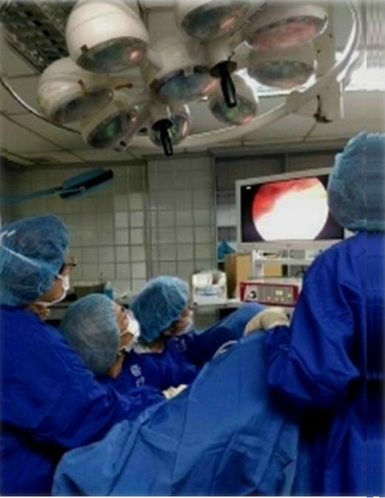
Hysteroscopy
The availability of hysteroscopy services at the hospital provides valuable diagnostic and therapeutic options for women’s health. Hysteroscopy is a minimally invasive procedure that allows doctors to examine the inside of the uterus using a thin, lighted tube called a hysteroscope. The procedure can be performed under conscious sedation or general anesthesia, depending on the patient’s needs and the complexity of the procedure.
Under hysteroscopy, various operative procedures can be conducted to address specific uterine conditions. These may include:
- Removal of Polyps: Polyps are small, benign growths that can develop on the inner lining of the uterus (endometrium). Hysteroscopy allows for their precise removal, which is crucial for symptom relief and to prevent potential complications.
- Removal of Submucosal Fibroids: Submucosal fibroids are fibroids that grow inside the uterine cavity. Hysteroscopy enables the removal of these fibroids, which can cause heavy menstrual bleeding and other related issues.
- Adhesion Removal: Adhesions, also known as scar tissue, can form within the uterine cavity and may result from previous surgeries or infections. Hysteroscopy allows for the gentle removal of adhesions, which can improve fertility and alleviate menstrual problems.
- Treatment of Uterine Septum: A uterine septum is a congenital malformation where the uterus is divided by a wall or septum. Hysteroscopy can be used to correct this condition and improve reproductive outcomes.
By offering laparoscopy and hysteroscopy services, the hospital provides a comprehensive approach to the diagnosis and treatment of various gynecological conditions. Laparoscopy is another minimally invasive procedure that allows doctors to view and treat the pelvic organs through small incisions. It is commonly used for conditions such as endometriosis, ovarian cysts, and tubal issues.
Both hysteroscopy and laparoscopy are valuable tools for gynecologists to accurately diagnose and treat conditions affecting women’s reproductive health. These procedures typically result in shorter recovery times, less post-operative pain, and reduced scarring compared to traditional open surgeries. As a result, patients can experience improved outcomes and a faster return to their regular activities.
Specialty Clinics
Ask a question
Quick Contact
- Address Capitol Medical Center., Quezon Avenue Cor. Scout Magbanua St., Quezon City, Philippines, 1103
- Email info@capitolmedical.org
- Phone (+632) 8372-38-25







